A project scope template helps keep your workload manageable, prevents your project from veering off course, and ensures you meet deadlines and stay within budget. In this guide, we'll explore what it is, its contents, and how it can streamline your project planning. Plus, we'll provide you with a free, ready-to-use project scope template so you can get started immediately.
Note: If you're looking to supercharge your project planning process, Downtobid offers cutting-edge AI technology to identify bid packages, create custom subcontractor lists, and streamline bidding. Our platform turns complex construction plans into bid invites in minutes – not hours or days. [Upload your construction plans for free](https://downtobid.com/free-trial today.
Key Takeaways
- Project scope templates define goals, tasks, costs, deliverables, deadlines while preventing scope creep.
- Includes deliverables, exclusions, acceptance criteria, change control, assumptions, dependencies, constraints.
- Clear boundaries prevent scope creep causing burnout, missed deadlines, subpar work, reputation damage.
- Template provides starting point but needs customization to avoid missing or irrelevant items.
- Downtobid's AI identifies scopes from documents, matches qualified subcontractors with 60%+ response rates.
Project Scope Explained
Project scope involves defining and documenting specific project goals, tasks, costs, deliverables, and deadlines. The documentation that outlines these details is known as a scope statement or terms of reference. The document:
- outlines exactly what's included and what's not, providing a clear picture of the project's limits.
- spells out who's responsible for what, ensuring accountability across your team
- sets procedures for verifying and approving completed work
Before you kick off any work, you need to write a project scope and ensure it's agreed upon and signed by both your team and stakeholders. This step helps prevent misunderstandings and keeps scope creep in check.
Scope creep happens when changes sneak into your project without adjusting your budget or timeline. It often starts small - a tiny change here, a minor addition there. But before you know it, your whole project is on shaky ground. Some of its worst effects include:
- Pushing your team to burnout
- Making you miss crucial deadlines
- Forcing you to deliver subpar work
- Failing to meet your project's objectives
- Damaging your reputation
The best way to avoid scope creep completely is to set clear boundaries before the project begins -- and that's exactly what a comprehensive project scope template can help you with.
What Does Our Project Scope Template Include?
The goal of any good project scope template is clarity — giving your project manager a clear roadmap to achieve success. That's why we've designed our template to strike an important balance: comprehensive enough to cover all the crucial bases, but lean enough to avoid unnecessary fluff.
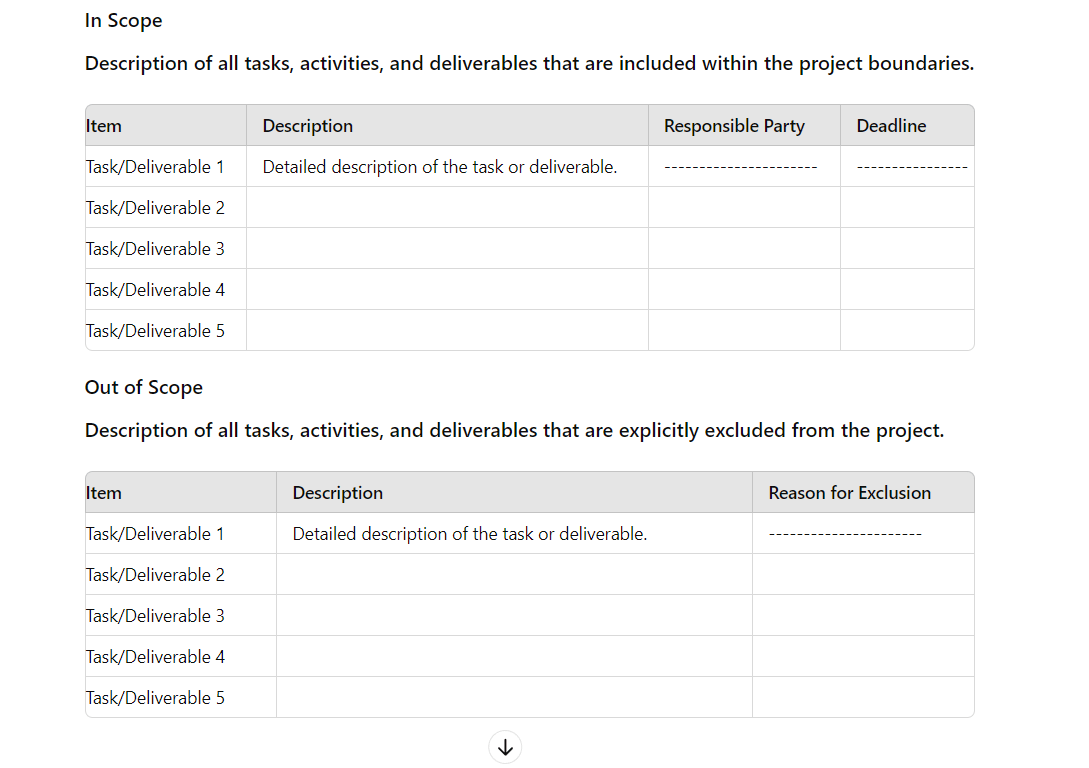
Here’s what you’ll find in our project scope template (which you can download here):
Project Deliverables
Deliverables cover a wide range of tangible outcomes that mark significant milestones. Here are some key examples:
- The final result of the construction, such as a building or bridge.
- Progress reports
- Design documents
- Design reviews
- Proposals
- Site investigation reports
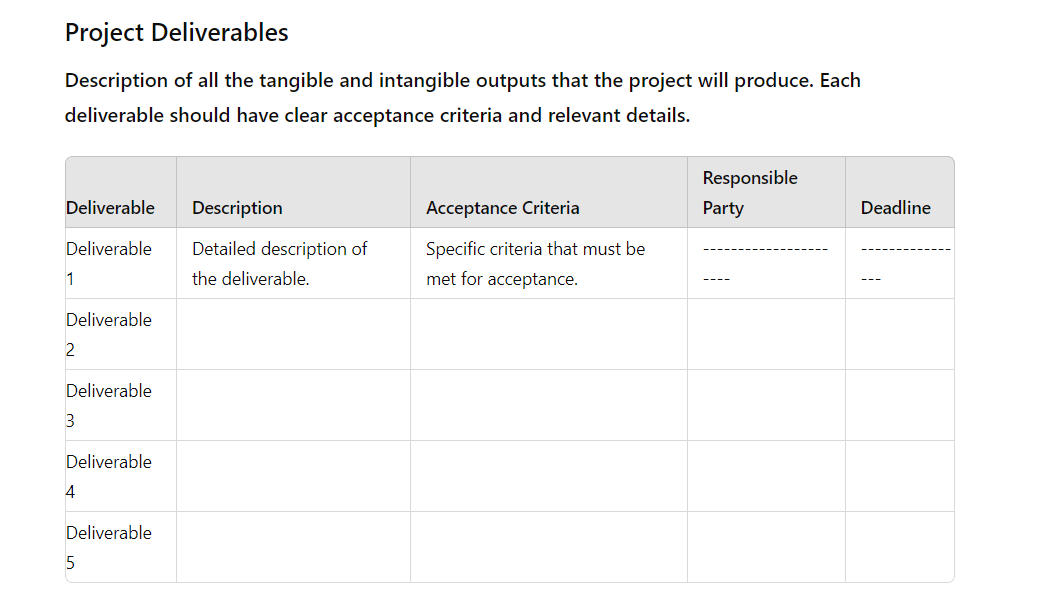
These deliverables can stand alone or be part of larger milestones, often interconnected and building upon each other throughout the project lifecycle.
Project Exclusions
When scoping a project, you're not just defining what's included but also what's excluded. Exclusions are aspects that fall outside your responsibility or project goals. If it's out of scope, it's beyond your control unless your team approves adding it after consultation with the client.
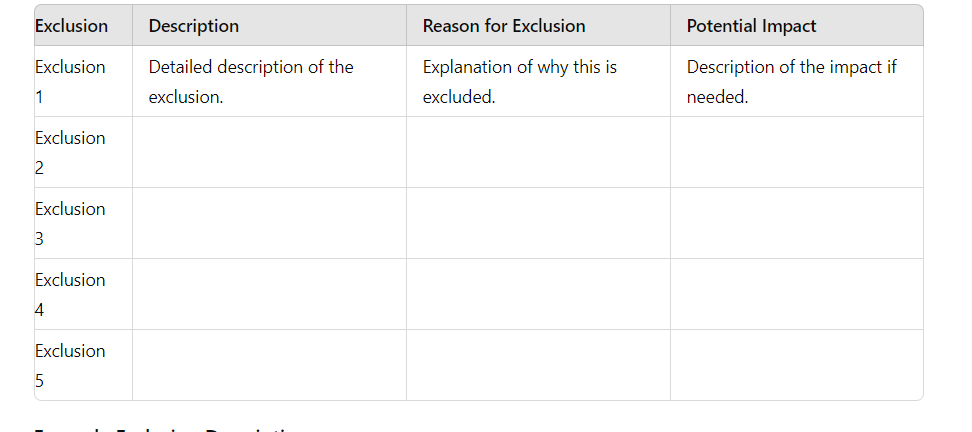
As we've mentioned earlier, clearly defining these exclusions in your project scope statement helps manage expectations and prevents misunderstandings with clients.
Acceptance Criteria
In multi-team projects, coordination is crucial to avoid conflicts and ensure everyone moves in the same direction. Defining acceptance criteria helps accomplish this coordination. They are the agreed-upon conditions that must be fulfilled for a project to be considered finished. They provide a clear benchmark for teams to follow, ensuring alignment and clarity across all project phases.
Change Control Process
Change control is a critical aspect of project management. It protects the integrity of your original plan while allowing for necessary adaptations.
It involves managing requests to change project scope, schedule, or deliverables systematically. Whether initiated by stakeholders, project managers, or your project team, these requests can range from minor schedule adjustments to significant new deliverables. The process determines who can approve or deny these requests.
Not all change requests are approved, though. Key stakeholders evaluate each request based on its impact on the project's goals, timeline, and resources.
Assumptions and Dependencies
Assumptions are key factors considered true or certain, even without concrete proof. They're like educated guesses about events or conditions expected during your project's lifecycle.
While they are necessary to begin planning, not all turn out to be accurate. The more realistic and well-founded your assumptions, though, the smoother your project will run.
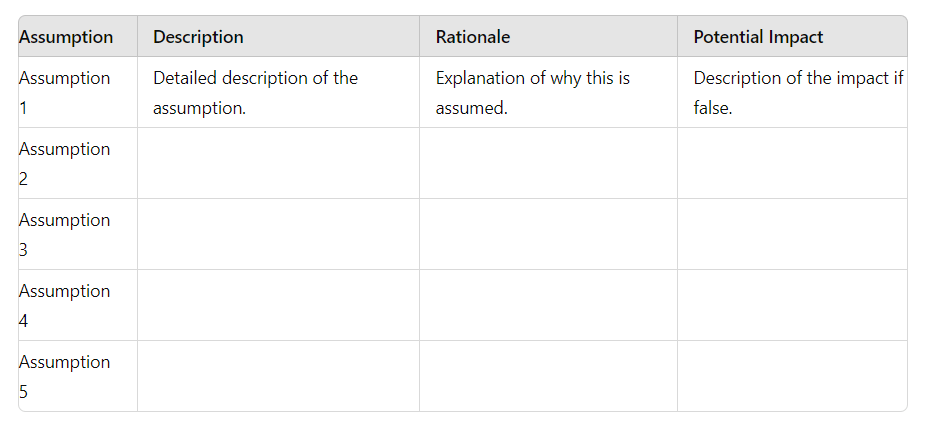
Dependencies, on the other hand, are tasks that hinge on the completion of other tasks. Mapping out dependencies helps in effectively planning and scheduling tasks based on the project's constraints and priorities.
Constraints
A constraint is anything that limits your project's scope, potentially affecting its speed, quality, and budget. The most common set of constraints is often referred to as the Triple Constraint:
- Scope: What exactly is the expected outcome?
- Time: What’s the deadline for delivering the project’s output?
- Cost: How much budget is available to achieve this outcome?
Changing any one of these elements affects the other two. For instance, extending the project timeline might increase costs or require scaling back on the project scope. Conversely, reducing the budget could impact the scope or timeline.
Proactively managing these constraints from the outset means you’ll be better equipped to handle changes and challenges as they arise.
What You Get With the Free Project Scope Document (and Its Risks)
Our template can help you save time in the following ways:
- Its straightforward layout makes it easy for all project team members to reference and understand.
- It includes common provisions, saving you from reinventing the wheel for each project.
- You can easily make changes and revisions as needed to ensure a successful project.
But project scope templates are designed to be your starting point, not your final destination. When making revisions, there's a risk of either omitting necessary items or leaving in irrelevant ones. This can happen when you quickly copy and paste requirements without making necessary adjustments. The result? Scopes of work that don't fully address your project’s specific requirements.
To truly optimize your scope management, you need to go beyond a static template. Below, we'll explain how a bid invitation platform like Downtobid saves you even more time with improved customization, ensuring thorough coverage of all your project's aspects.
Identify Scopes of Work Easily with Downtobid
An important thing to keep in mind when creating project scope statements: you'll often need to define smaller scopes of work that subcontractors can manage.
Think of your project as a complex puzzle. Each scope of work is a unique piece that fits perfectly with the others to create the big picture. Here’s how you can handle this process effectively:
Each scope should be assigned to a single subcontractor.
Your project scopes should account for everything in the contract, plans, and specifications. No gaps allowed.
Like slicing a pie, each piece (or scope) should be distinct. You can't give the same slice to two people
Sounds straightforward, but in practice, it's anything but simple.
This division of work can be incredibly time-consuming and complex. Typically, you'd spend hours scouring through construction documents, keynotes, schedules, and details to identify all required scopes and their respective bid packages.
And the tight deadlines – often just 2-3 weeks from receiving construction documents – don't make it any easier. This rush leaves little room for error, yet mistakes are almost inevitable given the complexity of the task.
But there’s a better way to streamline this process: Downtobid. Using AI, Downtobid can instantly identify scopes from extensive documents, eliminating the need for manual labor and page-turning.
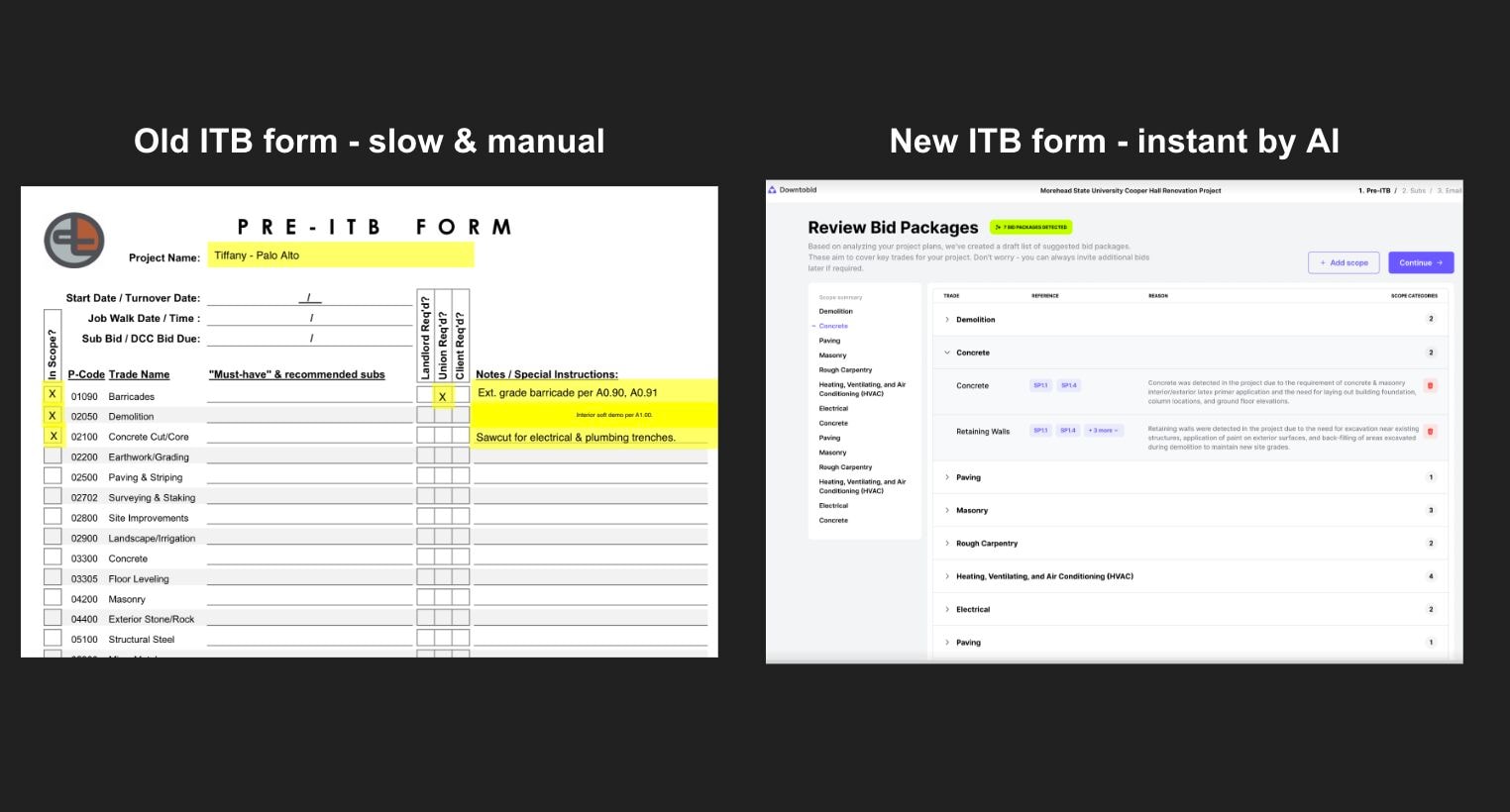
Here's how Downtobid's AI streamlines the process:
- It indexes and analyzes every plan sheet in your project.
- It identifies crucial construction callouts, notes, and schedules, linking them to their exact locations in the documents.
- All this information is neatly packaged into concise scope summaries, ready for your review.
The result? Within minutes, you've got a comprehensive list of potential scopes for your project. With these scopes, you can now focus on finding the right subcontractors for each task. And yes, Downtobid can help with that as well.
Find the Perfect Subcontractors for Your Project
AI bid invitation software have made it all too easy to blast out requests to every subcontractor in your database. But this shotgun approach rarely works. Subcontractors are overwhelmed with invitations, and yours will likely get lost in the shuffle.
To get qualified subcontractors on board and create a network of reliable partners for future projects, you need to make the invitation process as seamless as possible. This means inviting them only to projects that match their expertise, ensuring accurate scope alignment, and providing easy access to project plans and documents.
Downtobid excels in all these areas by:
- Generating a comprehensive list of required bid packages and then curating a list of local, prequalified subcontractors matched by their relevant capabilities.
- Creating compelling subject lines that drive higher open rates using project details like size, type, and location
- Generating tailored scope summaries and highlighting why each subcontractor is a great fit for your construction project
Scheduling a thoughtful cadence of 2-3 follow-ups, timed perfectly based on your bid timeline.
Early adopters of AI-powered subcontractor selection are seeing impressive results:
- Over 60% response rate to bid invitations
- More than 80 bids generated for a single project
You can try out the platform for free to experience similar results.